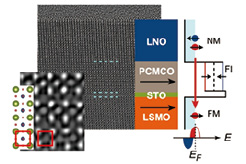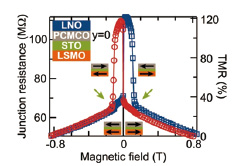Spin Filtering in Oxide Tunnel Junctions
I. Ohkubo, T. Harada, and M. Lippmaa
The operation of conventional functional tunnel devices, such as tunnel magnetoresistance junctions or Josephson junctions, is derived from the physical properties of the electrode materials, such as soft ferromagnets or superconductors. The tunnel barrier is usually a passive element in a junction, simply providing a suitable separation between the functional electrodes. The appearance of a ferromagnetic insulator state in mixed-valent manganites opens a possibility to construct a different type of junction, where the electrodes are passive and the functional element is the tunnel barrier itself. The junctions developed in this project contain tunnel barriers made of 10 to 12 unit cells of Pr0.8Ca0.2Mn1-yCoyO3 [1]. The ferromagnetic insulating state can be achieved by a suitable Pr/Ca ratio, while the saturation magnetization can be adjusted by Co doping. The electrodes of the junctions were made of a normal metal LaNiO3 and a ferromagnetic metal La0.6Sr0.4MnO3, as illustrated in Fig. 1. Electrons tunneling from the LaNiO3 electrode to the La0.6Sr0.4MnO3 side see different barrier heights, depending on spin state, due to an exchange splitting in the magnetic barrier layer. The spin injection rate into the ferromagnetic La0.6Sr0.4MnO3 electrode is thus different for spin-up and spin-down electrons.

Fig. 1. Cross-sectional electron microscope image and a schematic diagram of a spin-filter tunnel junction consisting of normal metal (NM) LaNiO3 (LNO) injection electrode, a Pr0.8Ca0.2Mn1-yCoyO3 (PCMCO) tunnel barrier, a SrTiO3 (STO) spacer, and a ferromagnetic (FM) spin detector La0.6Sr0.4MnO3 (LSMO).

Fig. 2. Tunnel magnetoresistance response of a spin-filter tunnel junction at 4 K, showing a resistance switching ratio of over 100%.
The La0.6Sr0.4MnO3 layer in the junction works not only as a metallic electrode but also as a built-in ferromagnetic spin detector. Due to strong spin polarization in La0.6Sr0.4MnO3, a spin-filtered tunneling current can only flow through the device when the magnetization directions in the ferromagnetic barrier and electrode layers are parallel. The efficiency of the tunnel barrier spin filter can therefore be determined easily by measuring the junction resistance as a function of an applied magnetic field (Fig. 2). Such a plot shows high resistance when the applied field is has just changed sign and the magnetically soft La0.6Sr0.4MnO3 electrode layer magnetization has flipped antiparallel to the tunnel barrier layer. Above the coercive field of the barrier layer, at an applied field of about 200 mT, the whole device magnetizes in the same direction and the total resistance drops sharply. The magnetoresistance ratio of over 100% is among the largest seen for any spin-filter junction.
Spin-filter junctions have several interesting uses, the most important being an efficient spin injector for semiconducting spintronic devices. Since the material in contact with a semiconductor is insulating, a spin-filter tunnel junction injector does not suffer from an impedance mismatch that occurs when a ferromagnetic metallic electrode is used as a spin-polarized current source in a semiconductor device. Analysis of spin filter efficiencies and inelastic electron tunneling spectroscopy showed that the choice of the normal metal electrode material is important in achieving efficient spin injection [2]. The use of a perovskite-type LaNiO3 electrode that was lattice matched (Fig. 1) with the insulator layer greatly increased the magnetoresistance ratio of the junctions, indicating improved spin filtering contrast. An approximate matching of the Fermi surface shapes of the electrode materials appeared to reduce scattering of tunneling electrons, further improving the spin filter efficiency.
References
- [1] T. Harada, I. Ohkubo, M. Lippmaa, Y. Sakurai, Y. Matsumoto, S. Muto, H. Koinuma, and M. Oshima, Adv. Funct. Mater. 22, 4471 (2012).
- [2] T. Harada, I. Ohkubo, M. Lippmaa, Y. Sakurai, Y. Matsumoto, S. Muto, H. Koinuma, and M. Oshima, Phys. Rev. Lett. 109, 076602 (2012).
